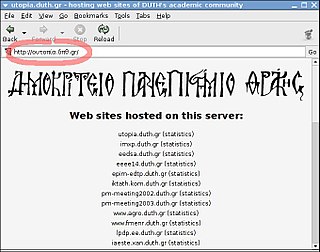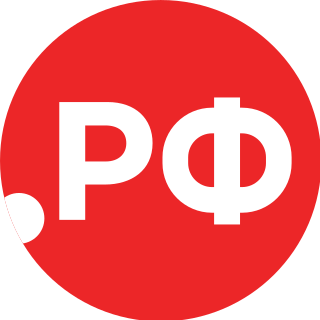
The Internet Corporation for Assigned Names and Numbers is a global multistakeholder group and nonprofit organization headquartered in the United States responsible for coordinating the maintenance and procedures of several databases related to the namespaces and numerical spaces of the Internet, ensuring the Internet's stable and secure operation. ICANN performs the actual technical maintenance work of the Central Internet Address pools and DNS root zone registries pursuant to the Internet Assigned Numbers Authority (IANA) function contract. The contract regarding the IANA stewardship functions between ICANN and the National Telecommunications and Information Administration (NTIA) of the United States Department of Commerce ended on October 1, 2016, formally transitioning the functions to the global multistakeholder community.
A top-level domain (TLD) is one of the domains at the highest level in the hierarchical Domain Name System of the Internet after the root domain. The top-level domain names are installed in the root zone of the name space. For all domains in lower levels, it is the last part of the domain name, that is, the last non-empty label of a fully qualified domain name. For example, in the domain name www.example.com, the top-level domain is .com. Responsibility for management of most top-level domains is delegated to specific organizations by the ICANN, an Internet multi-stakeholder community, which operates the Internet Assigned Numbers Authority (IANA), and is in charge of maintaining the DNS root zone.

In the Internet, a domain name is a string that identifies a realm of administrative autonomy, authority or control. Domain names are often used to identify services provided through the Internet, such as websites, email services and more. Domain names are used in various networking contexts and for application-specific naming and addressing purposes. In general, a domain name identifies a network domain or an Internet Protocol (IP) resource, such as a personal computer used to access the Internet, or a server computer.
A domain name registry is a database of all domain names and the associated registrant information in the top level domains of the Domain Name System (DNS) of the Internet that enables third party entities to request administrative control of a domain name. Most registries operate on the top-level and second-level of the DNS.
The domain com is a top-level domain (TLD) in the Domain Name System (DNS) of the Internet. Created in the first group of Internet domains at the beginning of 1985, its name is derived from the word commercial, indicating its original intended purpose for subdomains registered by commercial organizations. Later, the domain opened for general purposes.

The domain name .org is a generic top-level domain (gTLD) of the Domain Name System (DNS) used on the Internet. The name is truncated from 'organization'. It was one of the original domains established in 1985, and has been operated by the Public Interest Registry since 2003. The domain was originally "intended as the miscellaneous TLD for organizations that didn't fit anywhere else." It is commonly used by non-profit organizations, open-source projects, and communities, but is an open domain that can be used by anyone. The number of registered domains in .org has increased from fewer than one million in the 1990s, to ten million in 2012, and held steady between ten and eleven million since then.

An internationalized domain name (IDN) is an Internet domain name that contains at least one label displayed in software applications, in whole or in part, in non-Latin script or alphabet or in the Latin alphabet-based characters with diacritics or ligatures. These writing systems are encoded by computers in multibyte Unicode. Internationalized domain names are stored in the Domain Name System (DNS) as ASCII strings using Punycode transcription.
A domain name registrar is a company that manages the reservation of Internet domain names. A domain name registrar must be accredited by a generic top-level domain (gTLD) registry or a country code top-level domain (ccTLD) registry. A registrar operates in accordance with the guidelines of the designated domain name registries.

Domain name speculation, popular as domain investing, domain flipping or domaining in professional jargon, is the practice of identifying and registering or acquiring generic Internet domain names as an investment with the intent of selling them later for a profit.
A country code top-level domain (ccTLD) is an Internet top-level domain generally used or reserved for a country, sovereign state, or dependent territory identified with a country code. All ASCII ccTLD identifiers are two letters long, and all two-letter top-level domains are ccTLDs.
Generic top-level domains (gTLDs) are one of the categories of top-level domains (TLDs) maintained by the Internet Assigned Numbers Authority (IANA) for use in the Domain Name System of the Internet. A top-level domain is the last level of every fully qualified domain name. They are called generic for historical reasons; initially, they were contrasted with country-specific TLDs in RFC 920.
A sponsored top-level domain (sTLD) is one of the categories of top-level domains (TLDs) maintained by the Internet Assigned Numbers Authority (IANA) for use in the Domain Name System of the Internet, alongside country-code top-level domains (ccTLD) and generic top-level domains (gTLD).
In the Domain Name System (DNS) hierarchy, a second-level domain is a domain that is directly below a top-level domain (TLD). For example, in example.com, example is the second-level domain of the .com TLD.

.web is a proposed top-level domain (TLD) that was created and assigned by an auction process to several bidding companies. It was awarded to Nu Dot Co LLC, which is primarily funded by Verisign.

The domain name .рф is the Cyrillic country code top-level domain for the Russian Federation, in the Domain Name System of the Internet. In the Domain Name System it has the ASCII DNS name xn--p1ai. The domain accepts only Cyrillic subdomain applications, and is the first Cyrillic implementation of the Internationalizing Domain Names in Applications (IDNA) system. The domain became operational on 13 May 2010. As of 2014 it is the most used internationalized country code top-level domain, with around 900,000 domain names.
.music is a community-based top-level domain name (TLD) operated for the benefit of the global music community. It was one of the most highly contested new gTLDs, with eight applicants in contention.
An internationalized country code top-level domain is a top-level domain in the Domain Name System (DNS) of the Internet. IDN ccTLDs are specially encoded domain names that are displayed in an end user application, such as a web browser, in their language-native script or alphabet, such as the Arabic alphabet, or a non-alphabetic writing system, such as Chinese characters. IDN ccTLDs are an application of the internationalized domain name system to top-level Internet domains assigned to countries, or independent geographic regions.
A landrush period is the time during which domain names are available for registration, usually to a closed group, to entities that do not own a trademark in the name they wish to register, for example generic terms like loan or car, and thus would not qualify for registration during the sunrise period. Orders may or may not be treated on a first-come-first-served basis. This period follows the sunrise period just after the launch of a new top-level domain or second-level domain during which, for example, owners of trademarks may register a domain name containing the owned mark, but a landrush period precedes a period of general availability, when any qualifying entity can register any name on a first come first-served basis.

.top is a generic top-level domain, officially delegated in ICANN's New gTLD Program on August 4, 2014.

.monster is a new generic top-level domain (gTLD) owned by XYZ.com. Originally delegated in 2014 by the employment website Monster.com as a brand-specific domain name, .monster was acquired by XYZ in 2019 as a general domain.









